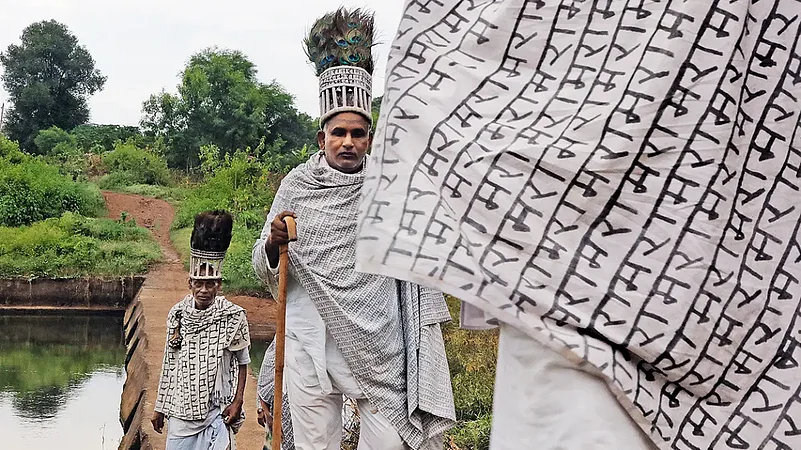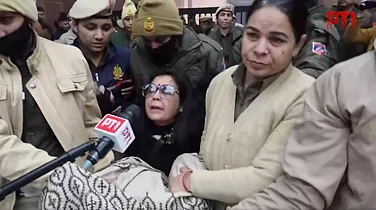They begin their day singing bhajans to Lord Rama. Then, they read stanzas of Ramcharitmanas, the 16th-century epic poem on the exploits of Ram by Tulsidas. They sit in groups, reciting the many names of their god, and sometimes they dance in circles, wearing a shawl with Ram’s name printed on it.
They are all from the Ramnami Samaj, a community in Chhattisgarh that found a unique way of subverting India’s brutal caste system, by tattooing Ram’s name on their bodies and faces, including their eyelids.
Most Ramnamis are Dalit, who are at the bottom of the caste pyramid and have been facing social and economic exclusion for centuries. “Whoever loves Ram and chants his name and adopts our rules—gives up alcohol and eats only vegetarian food—is a Ramnami,” says Rambhagat Sarkela, now in his 60s, a resident of Chandli Deeh village in Chhattisgarh.
In recent years, however, Ramnamis have faced many challenges. Their numbers have been falling. Many of the youths in the community are also reluctant to tattoo their bodies.
“Ram is in our hearts, we love him,” says Kunj Bihari, a science student at a college in Bilaspur, about 115 km northeast of Chhattisgarh’s capital Raipur. But he fears that tattoos on his body might prevent him from getting a job.
There are various accounts of the origins of the community in the 1890s. Vishakha Khetrapal, a researcher of social movements in central India, locates it in the socio-cultural churn of the mid-19th century that led to the founding of several other sects, such as Kabirpanthis and Satnamis. These movements challenged “the existing political and religious structures”, she writes in her paper, “The Ramnamis of Chhattisgarh: Wearing Ram in Defiance of Casteism”, published by the research website Sahapedia in 2019.
Many historians claim the movement is an off-shoot of the Satnami sect and was found by Parsuram Bhardwaj, a Dalit sharecropper born in the mid-19th century in Charpara village, in the Janjgir-Champa district of Chhattisgarh.
“According to a local legend, Parsuram contracted leprosy and, due to the attached social stigma, decided to live as a renunciant. During this time, he met a sage who blessed him and asked him to continue reading the Ramayana. The next morning, Parsuram discovered that all signs of illness had disappeared from his body, and instead, the word ‘Ram-Ram’ appeared as a tattoo on his chest,” writes Khetrapal.
Religious scholar Ramdas Lamb, in his book Rapt in the Name: The Ramnamis, Ramnam, and Untouchable Religion in Central India (2002), however, claims the Ramnamis are different from the Kabirpanthis and Satnamis.

“Parsuram did not attempt to Sanskritise his followers to make them more acceptable to caste Hindus. He knew well the teachings and rules of Ghasidas (founder of the Satnami sect), as many of his community followed them, but he believed that the Satnami movement had failed to gain the respect of most caste Hindus,” writes Lamb.
Surendar Lahre, 24, a resident of Akaltara village in Janjgir-Champa district, says Parsuram was a Chamar—a Dalit subcaste who work as tanners. “Our ancestors did not like to be called Chamar, which was a derogatory term,” says Lahre. “So they opted for these sects.”
ALSO READ: Asura: The Last Words Uttered By Ravan
At the time of Parsuram’s death in the 1920s, there were at least 20,000 Ramnamis, writes Lamb. But not all of them were Dalit, claims Gularam, general secretary, Akhil Bhartiya Ramnami Samaj, an organisation of the community. “There were many Brahmins too, like Bajrang Das Vaishnav, who also became a Ramnami.”
The distinctive feature of the community is the tattoo of Ram with which many Ramnamis cover their bodies and their faces. Senior community members use wooden needles and black ink from soot to tattoo the younger members. The process is often quite painful. The process is called ankit karna—literally, writing—instead of the traditional Hindi term, gudai. “Ram is the only truth in the world,” says Gularam. “No one can stop us from taking his name. We don’t need a temple. Ram is on our bodies.”
“I was four years old when I got my first Ram tattoo on my forehead,” says Saitbai, a resident of Salonikala village now in her 80s. “I’ve lived all my life following Ram, but my children don’t.” Her daughter, Prembai, now in her 50s, teaches at a government school. She refused to get tattooed.
Some Ramnamis are also migrating to other social and political movements. Lahre, for instance, has joined the Satnamis. “The history of Satnamis, the teachings of their founder, Guru Ghasidas Baba, and his fight for social equality, inspired me,” he says. Lahre has also joined the Bhim Army, a political unit promoting Dalit rights.
ALSO READ: In The Land Of Asurs Where God Is Formless
A visit to Chandli Deeh village in Chhattisgarh, where about a dozen Ramnami families live, reveals the endemic poverty in which the community exists. The only way to approach the village is over a narrow footbridge, under which runs a rain-fed rivulet. The road leading to the bridge is unmetalled. The village has electricity, but for potable water, the villagers have to walk several kilometres.
Ramnamis of the village are often invited by politicians and journalists across India. “We go to events to let people know we’re keeping the tradition alive,” says Gularam.
But in the village, many younger people are turning away from the traditional lifestyle.
“If the government had done something for us, or created job opportunities, we would have followed this tradition and kept our heritage alive,” said Lahre. “But we’re only another SC community that faces discrimination everywhere.”
Since the late-1980s, there have been waves of political assertion by Dalits—and other marginalised communities classified as Other Backward Classes. These movements have been described by French political scientist Christophe Jaffrelot as “the silent revolution”. Dalits, however, continue to be marginalised in educational institutions and organised sector employment. “We do some farming and work as labourers to make ends meet,” said Shanti Bai, 68. Her house in Chandli Deeh is made of wood, mud and cow dung.
“Our children are suffering. They can barely meet education and healthcare expenses. Most don’t have time to follow traditions,” she adds.
It is estimated that there are about 15,000–18,000 Ramnamis in India. But while the number of their tattooed members might be in decline, their popularity is rising, says Gularam. “A new generation is drawn to our bhajans,” he adds. “There are many devotees at our annual fair.”
Ramnamis do not believe in idol worship, but they establish stambhs (pillars) as a site for their rituals. There are more than 65 Ramnami pillars in Chhattisgarh. “Every year, a Ramnami village organises a fair near one of the stambhs,” says Lahre. “The next mela will be next held on January 2 next year at Chandli Deeh.” The date of the mela depends on the Hindu lunar calendar, but it usually falls in the month of Poush (mid-December to mid-January in the Gregorian calendar).
A popular custom at the mela are weddings. “In the 1950s, to make weddings more affordable to the rural masses, the sect instituted the practice of performing marriages at the mela,” writes Lamb.
Lahre’s parents, too, were married at one such mela. But these have been discontinued since 2001, as community leaders felt that this way, the families of the groom and the bride hardly got to know each other, which could result in the marriage breaking down.
(This appeared in the print edition as "Ink Masters Write the Name of Their Lord")


























